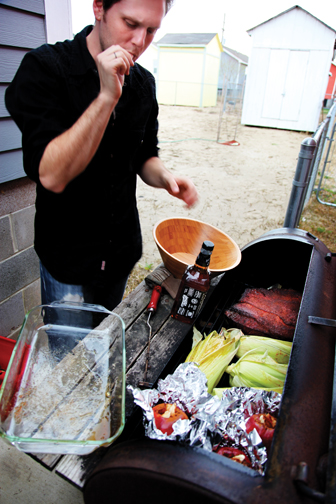“Originally from Houston, I basically learned to make smoked brisket from everyone in the family. Most of my family comes from cattle barons; there’s always a bunch of beef around. It’s kind of like here, where everyone knows how to make red beans and rice. In Texas, everyone knows how to smoke barbecue.
I make smoked brisket maybe twice a month. It’s an all-day thing. Kind of like making red beans, you let it go and go do other things, go to the store and come back, go do whatever and come back, make sure the fire is still set. I like to keep the temperature between 150 and 200. The heat and the smoke come from the offset firebox and go through here, through the barrel. There are electric smokers that’ll keep the set temperature with propane, but this is using charcoal and wood, so you always have to adjust. If it gets too hot you have to close the vents a little bit, or if it gets too low, open the vents and add some coals. Propane will keep the temperature at a steady 250, which is too hot to smoke brisket. It’ll come out dry. With charcoal, you have to check it often, but you get a lower heat and it’s more traditional. It’s always the propane versus the charcoal debate, but charcoal is usually the way to go. You’ll get a lot of flack if you don’t cook over charcoal in Texas. Use propane and it’s considered being lazy. It’s like eating Blue Runner’s red beans instead of making them yourself.
I use hickory wood because I like the flavor. You can buy it at the grocery store, in packs; sometimes you can find them at gas stations. Wherever they sell charcoal, they’ll sell the wood. It comes in little chips and you soak the chips in water for 30 minutes and they’ll add the flavor and the smoke.
The meat shrinks when you cook it. We usually get a big cut, 10 to 12 pounds, but sometime you don’t want to be out here for 12 hours or more. Today we got a smaller cut. With a seven-pound cut, I can be out here for about eight hours. You smoke it for about an hour or more per pound. You don’t want the butcher to cut all the fat off because you want to put the fat on the topside, about three quarters of an inch. Brisket is a tough cut of meat, and you have to slow-cook it. Knowing when it’s done is a little bit of a guess, a bit like seeing and knowing. Some people say you should be able to put a fork in it and lift it up, but you don’t want to do that. After the brisket is cooked you want to let it sit for about 30 minutes to an hour, just on a plate. If you cut it right away, all the juices are going to come out and it’s going to get dry. After it sits you can trim the fat off.
When you buy the cut, you want it to make a semi-circle when you pick it up in the middle, kind of let it drape over your hand. Then you know there’s enough fat inside. If it stays kind of straight, it’s going to be tough and chewy.
I got this pit from Jesse McBride. It was his neighbor’s and his neighbor left it and Jesse was the last one to move out of his building. He called me and his friend had a truck. It is really heavy. It takes two people just to roll it.
Once we took this to Frenchmen and tailgated our gig. We set it up in front of the Blue Nile, right on a truck. It turned out to be a good leverage tool to get people to gigs, giving them free food. It was a good crowd that night. People were trying to give us money. ‘Just buy a ticket. Go inside.’
To keep the meat from drying out, I put a pan of water underneath the meat. It catches the juices and keeps the pit nice and moist. I come out to check the fire about once an hour, add coals or open it up a little bit, add more wood chips, I’ll put a couple of handfuls.
I use about three bags of wood chips [100 cubic inches each]. Coals, I use the three-second rule. If you can put your hand in there for more than three seconds, it’s not hot enough. If I see the temperature going down to 150, I throw two-three handfuls of coals in.
When the meat is done, I’ll slice it against the grain into half-inch strips. Actually, I’ll probably get full by cutting it and eating while I cut it, just standing here. I eat it straight, or on a sandwich, but it’s usually more meat than bread. I usually don’t make a sauce. I only made a sauce once.
If I’m going to smoke, I’ll stick to brisket because brisket is my favorite. I guess I’m just not a pork fan. I do ribs, beef ribs, but then we’ll grill, use the smoker as a grill.
For brisket you have to use a dry rub, as opposed to a marinade. A dry rub keeps all the juices inside the meat. About a quarter cup of Bubba’s Barbecue Rub for Brisket, I bought this in San Antonio. It’s got chili powder, paprika, garlic salt, onion powder, all the basic stuff. I put it all over the meat the day before, cover it with plastic and let it sit in the fridge overnight. Rub it, refrigerate it.
[Shouting to wife in adjacent room:] Can I put something on the record? On whose gumbo is better? Can I go on the record?
Wife: Yes.
Well, she likes my gumbo better than her mom’s, and my cooking better than her mom’s cooking.”





